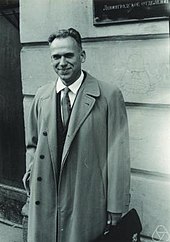Vladimir Abramovich Rochlin

Wladimir Abramovich Rochlin ( Russian Владимир Абрамович Рохлин , English transliteration Vladimir Abramovich Rokhlin ; born August 23, 1919 in Baku , † December 3, 1984 in Leningrad ) was a Soviet mathematician who dealt with topology , ergodic theory and real algebraic geometry .
Life
Rochlin came from a Jewish family. His mother Henrietta Levenson studied medicine in Paris, his grandmother Clara Levenson was one of the first Russian doctors. His grandfather, Emmanuil Levenson, was a wealthy businessman. His father, Abram Rokhlin, was a social democrat and was imprisoned during the Stalinist terror and shot in 1941. He studied from 1935 at the Lomonossow University in Moscow with Andrei Kolmogorow and Lev Semjonowitsch Pontryagin . In 1941 he volunteered for the Red Army and spent several years in German prison camps and then two years in a Soviet prison camp. He was only released through the use of his former teacher, Pontryagin, who turned personally to the head of the secret service Beria and then passed Rochlin off as his personal secretary (Pontryagin was blind), since otherwise he would not have received a residence permit for Moscow. In 1947 he received his doctorate from Abraham Plessner in Moscow (The Lebesgue space and its automorphisms). In 1952 he attracted attention with his signature theorem for four-dimensional manifolds. There is a necessary criterion for the existence of a spin structure on a 4-manifold: The signature of the sectional shape (a square shape in the second cohomology group) must be divisible by 16. Rochlin proved the theorem from the property of the third stable homotopy groups of the spheres, which he proved, to be cyclic with period 24. According to Friedrich Hirzebruch , it follows from the Atiyah-Singer index set . Other evidence comes from Michel Kervaire and John Milnor, and Michael Freedman and Robion Kirby .
He also worked on distinctive classes, homotopy theory and cobordism theory. He also made significant contributions to real algebraic geometry (the 16th Hilbert problem ). Before his death, Rochlin was working on an overview monograph of the area, but it was not completed because it was constantly in flux as an active research area.
In the measure theory he led in 1940 to the standard probability space (Lebesgue-Rokhlin probability space) and the Rokhlin decomposition.
From 1959 he was a professor at the University of St. Petersburg (then Leningrad). His students include Michail Gromow (PhD 1968), Jakow Eliaschberg , Oleg Wiro , Viatcheslav Kharlamov and Anatoli Werschik . His son Vladimir Rochlin is also a well-known mathematician. Rochlin's uncle Kornei Ivanovich Tschukowski was an author of children's books.
literature
- À la recherche de la topologie perdue. I. You côté de chez raw woman. II. Le côté de Casson. Edited by Lucien Guillou and Alexis Marin. Progress in Mathematics, 62. Birkhauser Boston, Inc., Boston, MA, 1986. ISBN 0-8176-3329-4
- VG Turaev, AM Vershik (Ed.): Topology, ergodic theory, real algebraic geometry: Rokhlin's Memorial, AMS, 2001
- AM Vershik: Vladimir Abramovich Rokhlin - A biographical tribute (23.8.1919-3.12.1984) , Ergodic Theory and Dynamical Systems, Volume 9, 1989, pp. 629-641
- Wladimir Arnold, Oleg Wiro, Andrei Kolmogorow, Sergei Novikow, Anatoli Werschik, Jakow Sinai, Dmitry Fuchs: Vladimir Abramovich Rokhlin (obituary), Russ. Math. Surveys, Vol. 41, 1986, pp. 189-195
Works (selection)
- with Dmitry Fuchs : Beginners Course in Topology Geometric chapters. Translated from the Russian by A. Iacob. University text. Springer Series in Soviet Mathematics. Springer-Verlag, Berlin, 1984. xi + 519 pp. ISBN 3-540-13577-4
- Lectures on the entropy theory of transformations with invariant measure. (Russian) Uspehi Mat. Nauk 22 1967 no. 5 (137), 3-56.
- with Michail Gromow : Imbeddings and immersions in Riemannian geometry. (Russian) Uspehi Mat. Nauk 25 1970 no. 5 (155), 3-62.
- Complex topological characteristics of real algebraic curves. (Russian) Uspekhi Mat. Nauk 33 (1978), no. 5 (203), 77-89, 237.
Web links
Individual evidence
- ↑ Interview by Wladimir Arnold, Notices AMS 1997, PDF file
- ↑ Rokhlin, Congruences modulo sixteen in the sixteenth Hilbert problem, Functional Analysis and Applications, Volume 6, 1972, pp. 301-306, Part 2, Volume 7, 1973, pp. 91-92
- ^ Yandell, The honors class, AK Peters 2003, p. 278
- ↑ Rokhlin, On the fundamental ideas of measure theory, Translations AMS, Series 1, Volume 71, 1952, pp. 1–54 (Russian original in Mathematische Sammlung (New Series), Volume 25, 1949, pp. 107–150)
| personal data | |
|---|---|
| SURNAME | Rochlin, Vladimir Abramovich |
| ALTERNATIVE NAMES | Rokhlin |
| BRIEF DESCRIPTION | Soviet mathematician |
| DATE OF BIRTH | August 23, 1919 |
| PLACE OF BIRTH | Baku |
| DATE OF DEATH | 3rd December 1984 |
| Place of death | Leningrad |